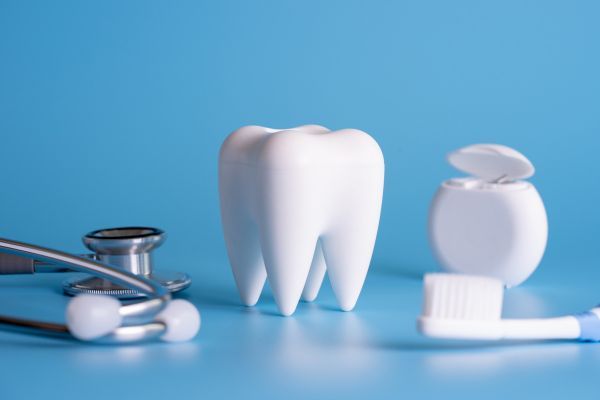Your dentist is an expert in protecting your oral health. In addition to providing preventive care, they diagnose and treat the teeth, gums, mouth, and jaw. Dentists improve self-confidence with functional and cosmetic restorations. Common procedures which can restore the health and the appearance of your smile include:
Regular Exams and Cleanings
Regular checkups are one of the best ways you can maintain your oral health. The American Dental Association recommends an exam and cleaning every six months, although some dental conditions make more frequent visits advisable.
Your dentist will examine your teeth, gums, and mouth thoroughly, looking for indications of tooth decay, damaged fillings, gum disease, oral cancer, and any other oral concerns. X-rays will be taken if necessary to check the health of tooth and bone in hard-to-see locations and below the gum line.
Your hygienist will examine the surface of your teeth and your gum health. This might involve evaluating the depth of gum pockets and gum attachment to the teeth. Special tools will be used to clean the teeth and remove tartar, the hardened plaque, which can’t be removed at home. Your teeth will be polished and flossed, and fluoride might be applied.
A dental exam usually takes 30-60 minutes. After your checkup and cleaning, your dentist and hygienist will give you tips for improving and maintain your oral care.
Bonding
Dental bonding is a conservative cosmetic treatment, which uses composite resin to repair and restore the tooth surface.
Bonding is commonly used to repair chips and minor cracks, cover stained or discolored enamel, close small gaps between teeth, remodel the contours of teeth, which are undersized, crooked, or misshapen, and rebuild areas where enamel erosion has taken place.
Bridges
A bridge is a restoration that makes your smile complete again after tooth loss.
Bridges use prosthetic teeth to “bridge” the gaps caused by missing teeth. These prosthetic teeth are crafted from metal, porcelain, or porcelain fused to metal, and are matched in size, shape, and color to the teeth they’re replacing for a natural appearance. A bridge can replace up to four adjacent teeth but is typically used to replace one or two.
Traditional bridges are fixed in place and are anchored by crowns placed on the healthy teeth on each side of the gap. Bridges can also be attached to dental implants. Because a bridge requires healthy teeth, gums, and bone for a long-lasting and successful restoration, any dental problems will need to be treated beforehand.
Crowns
When a tooth has suffered structural or cosmetic damage, a dental crown can restore a tooth’s function and appearance. A crown is a custom-made “cap” which covers the entire visible surface of the tooth. Crowns are used to strengthen and protect teeth with extensive decay, breakage, or cracks, restore a tooth after a root canal procedure, cover a discolored or irregularly shaped tooth, serve as an anchor for a dental bridge, or complete a dental implant procedure.
Most crown placements require two appointments: one appointment to prepare the tooth and take an impression for crown fabrication, and one visit to fit and bond the crown to the prepared tooth. Crowns are available in several different materials. You can choose metal, porcelain, or composite resin based on factors such as durability, natural appearance, and cost.
Dentures
If you’ve lost some or all of your teeth because of trauma, periodontal infection, or decay, dentures are one option which can offer you a healthier, more attractive smile. Full or partial dentures make it easier to eat, chew, and speak clearly, support the cheeks and lips for a more youthful appearance, prevent remaining teeth from shifting out of place, and restore self-confidence.
Conventional full dentures are created and placed after the gums have healed following any extractions. Immediate dentures are placed directly after extraction, and typically require regular adjustments for fit and comfort. Partial dentures are secured to adjacent teeth, and, unlike bridges, are removable. Implant-supported full and partial dentures are also an option.
Extractions
Dentists strive to save teeth, but sometimes an extraction is necessary. Teeth might be too damaged to save due to trauma, infection, deep decay, or gum disease. Baby teeth which don’t fall out, wisdom teeth which pressure adjacent teeth, or severely overcrowded teeth might also be best treated with extraction.
Teeth are held in place by periodontal ligaments attached to the tooth socket. After the area is numbed, your dentist will use special tools to carefully loosen the tooth and lift it from the socket. A bone graft might be placed in the socket to protect your bone density before closing the site.
You’ll be given instructions to protect the site from infection and from a painful condition called dry socket. To prevent complications such as bone loss or shifting teeth caused by a missing tooth, you should discuss tooth replacement with your dentist.
Fillings
When decay is caught early, your dentist can treat your cavity conservatively by restoring your tooth’s function and appearance with a filling.
For most small to moderate cavities, direct fillings can be bonded to the tooth immediately after removing decay and cleaning and shaping the tooth. Composite resin, dental amalgam, and glass ionomer fillings are typically used for this type of single visit restoration.
An indirect filling restores molars and premolars with larger areas of damage or decay. An inlay fills the tooth surface inside the cusps, while an onlay typically covers the center of the tooth and one or more cusps. Indirect fillings can be made of composite resin, gold, or porcelain, and are created from a mold taken after the tooth is cleaned and prepped. The finished filling is bonded to the tooth at a second visit.
Fluoride Treatments
Fluoride is a naturally occurring mineral which strengthens tooth enamel and helps prevent tooth decay. Fluoridated drinking water and over-the-counter fluoride toothpastes and rinses help maintain tooth health. For even greater protection against cavities, your dentist might recommend a professional fluoride treatment.
Fluoride treatments are straightforward and take only a small amount of time. The fluoride is administered as a gel, varnish, rinse, or foam, and applied with a swab, brush, as a mouthwash, or in a tray.
While fluoride treatments are especially important for children, adults can benefit as well. Dexterity issues that can make brushing difficult, receding gums that expose part of the roots, and conditions like dry mouth can leave the teeth more vulnerable to cavities as we age.
Implant Restorations
Dental implants are a popular and effective way to replace lost teeth.
During the implant procedure, a cylinder or screw, usually made of titanium, is surgically implanted into the jawbone. The implant fuses with the bone over several months. Once the area has healed, an abutment is connected on one end to the inside of the implant. A crown is then securely attached to the other end of the abutment, which sits above the gum line. The result is a tooth which looks and functions just like a natural tooth.
Candidates for implants need healthy bone for the implant to succeed. If there are concerns with bone size or density, a bone graft can be performed first. After three to four months of healing, the jawbone generally has enough size and density to accept an implant.
Mouthguards
A mouthguard is essential protective gear whenever you participate in any sport or activity that could lead to dental trauma. Mouthguards are designed to absorb and distribute the force of impact on teeth, jaw joints, and jaws. Mouthguards also help prevent cuts and lacerations to the gums, lips, inner cheeks, and tongue.
You can choose a one-size-fits-all stock guard, or a “boil-and-bite” model that fits a bit more closely to your teeth and mouth. But your best protection comes with a custom mouthguard. Custom guards are more effective, more comfortable, more durable, and make it easier to speak and breathe.
Nightguards
Tooth grinding, or bruxism, puts hundreds of pounds of pressure on the teeth. Grinding damages teeth, dental work, and jaw joints. One of the simplest and most effective treatments for preventing the damage caused by bruxism is a nightguard.
Nightguards fit over the teeth to prevent them from touching directly, saving tooth and enamel from injury and wear. Not only do nightguards prevent contact, they spread the biting forces of the jaw over the surface of the guard to greatly reduce their impact. And because nightguards stop the jaw muscles from clenching tightly, there’s no excess stress placed on the temporomandibular joint.
Your dentist can create a custom nightguard tailored to your teeth and mouth for the most effective protection and the most comfortable fit.
Root Canal Treatment
When bacteria infect the tooth pulp, a root canal procedure is necessary. Root canal treatment prevents more widespread infection by removing infected pulp tissue and saves your natural tooth by restoring tooth strength and structure with a crown.
Root canal procedures are straightforward. After the area around the tooth is numbed, your dentist will make an opening in the crown to allow access to the pulp inside. Delicate dental instruments will be used to clean the inner tooth and removed bacteria and dead or dying tissue. The area will be thoroughly disinfected, and the inside of the tooth shaped, filled, and sealed.
A temporary filling or crown might be placed on the tooth to prevent bacteria and food from entering the site while a permanent crown is created. The entire process usually takes from one to three visits.
Sealants
Sealants are thin plastic coatings applied to the chewing surfaces of the back teeth, protecting them from bacteria and plaque. First, the tooth is cleaned and dried. An etching solution is brushed on the surface to roughen the area slightly, allowing the sealant to adhere more effectively. A thin coat of sealant is then painted on and hardened under a curing light.
Sealants are especially helpful for children when their permanent molars and premolars erupt because the irregular top surfaces of the molars are hard to clean thoroughly. Some children who still have their baby teeth and some adults might benefit from sealants as well. Talk to your dentist about the preventative care sealants can provide.
Veneers
A dental veneer is a thin, durable porcelain shell that is custom-fabricated to cover the front of a tooth. Veneers can restore the appearance of teeth with chips, cracks, and stains, can close small gaps between the teeth, and can reshape misshapen or slightly misaligned teeth. Because they are translucent, veneers closely match natural tooth enamel.
Applying veneers takes from two to three appointments, and, while the cost of veneers is comparable to the cost of crowns, veneers preserve more of the tooth’s underlying structure than crowns do.
Wisdom Teeth
Wisdom teeth often don’t have enough space to develop properly or to erupt without damaging your other teeth.
A fully impacted tooth never erupts, remaining inside the jawbone. The roots of neighboring teeth can be harmed by pressure from a trapped wisdom tooth, nearby teeth can be pushed out of alignment, or a cyst can develop around the impacted tooth. Even if you are symptom-free, regular exams and X-rays are necessary to monitor the condition of impacted teeth.
Partially impacted wisdom teeth never erupt completely. Food particles and bacteria are trapped by the partially exposed tooth and the gum tissue around it, making it very difficult to clean effectively. These teeth have a greater risk of decay and increase the risk of gum disease. They can also cause damage to neighboring teeth as they emerge.
For these reasons, wisdom tooth extraction is most often recommended during the teens or early twenties when the teeth begin erupting. The roots aren’t as large or as fully developed, the jawbone isn’t as dense, and recovery time is shorter.
Talk to your dentist to learn more about these procedures and to discover the further treatment options available to create and maintain a healthy, attractive smile.








